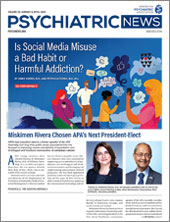Study Points to Risk Factors Predictive of Suicide After Emergency Visit
Abstract
The Psychiatric Services study underscores that suicidal ideation reflects an enduring vulnerability, not a short-term risk, and prevention depends on targeting scalable interventions for populations according to their risk stratification.
Prior self-injury and alcohol abuse are among the variables identified as predictive of suicidal behavior 12 months after an initial positive screen for suicide risk in the emergency department (ED), according to a report published December 1 in Psychiatric Services in Advance. Educational level, employment, and a history of depression were also implicated in risk of suicide, the report found.
Researchers from several institutions, who first presented the findings at a meeting of the American College of Emergency Physicians in 2014, analyzed data from the Emergency Department Safety Assessment and Follow-up Evaluation (ED-SAFE). The latter was an eight-center study designed to test an approach to universal screening for suicide risk and post-visit telephone intervention among ED patients.
ED-SAFE participants were selected by first determining whether the individual’s chart documented any screening for self-harm ideation or behavior. If documentation indicated that a patient had expressed self-harm ideation or behavior, the patient was approached for further eligibility screening. If the patient confirmed either active suicidal ideation or a suicide attempt within the past week and agreed to participate, then he or she went through the consent process and enrolled in the ED-SAFE study.
The participants completed a baseline assessment and were then followed post-discharge (from the ED or from inpatient services, if admitted) with a multi-method approach involving telephone assessments and chart reviews. After the index ED visit, each participant was telephoned by a trained interviewer at 6, 12, 24, 36, and 52 weeks for an outcome assessment.
At baseline, 577 out of 874 participants (66 percent) had suicidal ideation only, whereas 297 (34 percent) had a suicide attempt in the past week. In the 12 months after the index ED visit, 195 (25 percent) had documentation of having attempted or died by suicide.
The researchers found that participants were more likely to have suicidal behavior if, at the index ED visit, they reported that their level of education was high school completion or less, were unemployed, had a history of chronic health conditions, had a history of depression, had an ED visit within the past six months, or had a high suicidal ideation severity score on the Columbia Suicide Severity Rating Scale (C-SSRS). In addition, individuals reporting at least one suicide attempt, nonsuicidal self-injury, or suicidal ideation with intent or intent with a plan were significantly more likely than others to engage in future suicidal behavior.
“The findings that individuals who did not complete high school, who had an ED visit within the past six months, who were misusing alcohol, and who had a high C-SSRS suicidal ideation severity score (current) and a history of nonsuicidal self-injury were more likely than others to attempt or complete suicide within 12 months after the index ED visit all add to the extant research on risk factors for future suicidal behavior in an adult ED population and contribute to the goal of facilitating identification of ED patients at risk of future suicidal behaviors,” the study authors wrote.

Psychiatrist Gregory Simon, M.D., says individual-level interventions need to be scalable for the large group of people who show some risk for suicide but aren’t at ultra-high risk.
Greg Simon, M.D., a psychiatrist and senior investigator at the Group Health Research Institute (GHRI), told Psychiatric News the new data confirm that people who seek care for suicidal ideation are at high risk for suicide attempt over the next year. “Suicidal ideation reflects an enduring vulnerability—rather than just a short-term crisis,” he said. (Simon is on the editorial board of Psychiatric Services, but was not involved with this study.)
Simon and his colleagues at GHRI have focused on risk assessment within large health systems. A report in Psychiatric Services (December 2013) looked at suicide and self-harm using electronic records and PHQ-9 responses from outpatient visits to the Group Health Cooperative.
The researchers found that response to item 9 in the questionnaire regarding thoughts of death or self-harm was a strong predictor of suicide attempt and suicide death over the following year. The 13 percent of patients who reported thoughts of death or self-harm “more than half the days” or “nearly every day” accounted for 53 percent of suicide attempts and 54 percent of suicide deaths in the study.
After adjustment for age, sex, treatment history, and overall depression severity, responses to item 9 of the PHQ-9 remained a strong predictor of suicide attempt.
But another study appearing in the Journal of General Internal Medicine (June 2014) looking at deaths by suicide in the Mental Health Research Network health care systems serving eight states found that more than half of individuals who died by suicide did not have a mental health diagnosis, and only 24 percent had a mental health diagnosis in the four-week period prior to death.
That makes fashioning interventions that meet the risk stratification difficult. “At the high end of risk we know a lot, and we know we need intensive interventions, but at the other extreme, up to half of suicide attempts occur in people where we have no signal for risk at all,” Simon told Psychiatric News. “In the middle range are people who may have some indicators, including some mental health treatment.”
Simon and colleagues at GHRI are testing scalable interventions for the large group of individuals who fall into the middle range of risk. “We can’t really deliver individual-level interventions to people with no known risk indicators—in that group. … [W]e have to focus on means restriction. In the middle group, we can certainly deliver individual-level interventions. But given the number of people involved, they have to be scalable.” ■



